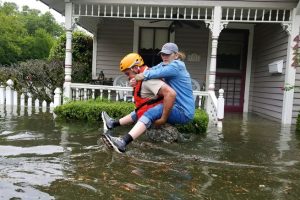BEAUMONT, Texas — Having experienced two major hurricanes and the deluge-producing Tropical Storm Harvey over the past 12 years, one becomes accustomed to certain sights over time.
After hurricanes Rita and Ike, the blue tarp became the symbol for damage for many and the recovery for some. The blue covers mostly came from a U.S.. Army Corps of Engineers and FEMA program called “Operation Blue Roof.” This is a free service in which damaged roofing can be covered for free for homeowners who sign a right of entry (ROE) form for contractors. The “blue” in blue roofs is so called due to the fiber-reinforced sheeting used as covers, or tarpaulins. Those tarps are blue.
I recall flying into the local airport when returning from a trip in 2008 in Washington, D.C., and noticed an abundance of blue roofing covers still in place from the September 2005 Rita.
So, Southeast Texas is now several weeks in recovery efforts from Tropical Storm Harvey. The majority of the storm damage from the Houston to Sabine River in Texas was a result of the unprecedented flooding.
Like the blue roofs from past hurricanes, now the symbol where I live and in many other places in Southeast Texas, is trash — and lots of it.
The Category 4 Hurricane Harvey made landfall Aug. 26, 2017, on the middle Texas Gulf Coast, where it caused severe wind and storm surge damage. But Harvey wasn’t through there.
Harvey moved inland becoming a Category 1 hurricane before being downgraded to a tropical storm. The track continued until reaching an area about 55 miles southeast of San Antonio. The storm then took a southeast turn before making a southwestern direction. And, it turned again, making a southeastern leg and eventually hugging the upper Texas coast. TS Harvey was a large-enough storm that its center never came all that near Houston even though the rain it produced was devastating.
The tropical storm made landfall for a final time on Aug. 30, 2017, near Cameron, La., about 50 miles east southeast from where I live in Beaumont. I remember when the center of the storm was about 45 miles south of here. It had rained for, I lost count of the days, it was flooding and the tropical storm actually had some pretty good gusts of winds. While I had no weather station, I could see the trees outside bending to and fro.
Most of the folks I know from this area, and I tend to agree, could never remember it raining so hard for for so long. This entire area and extending up into the East Texas pineywoods and into Western Louisiana saw an unbelievable drenching. Some preliminary National Weather Service reports put the rainfall around the Beaumont-Port Arthur-Orange Metropolitan area ranging from 36 to 60 inches over the course of the storm. Many of the unofficial reports in my area put the rain total at 55 inches. Our area has an average annual rainfall of almost 60 inches.
I have no idea how much damage was received from the time it made its first landfall until when it landed again as a tropical storm. In the area from Houston to the east in Texas, at least 70 people died from the flooding.
Recovery from Harvey, still undergoing, will take a long time to accomplish.



